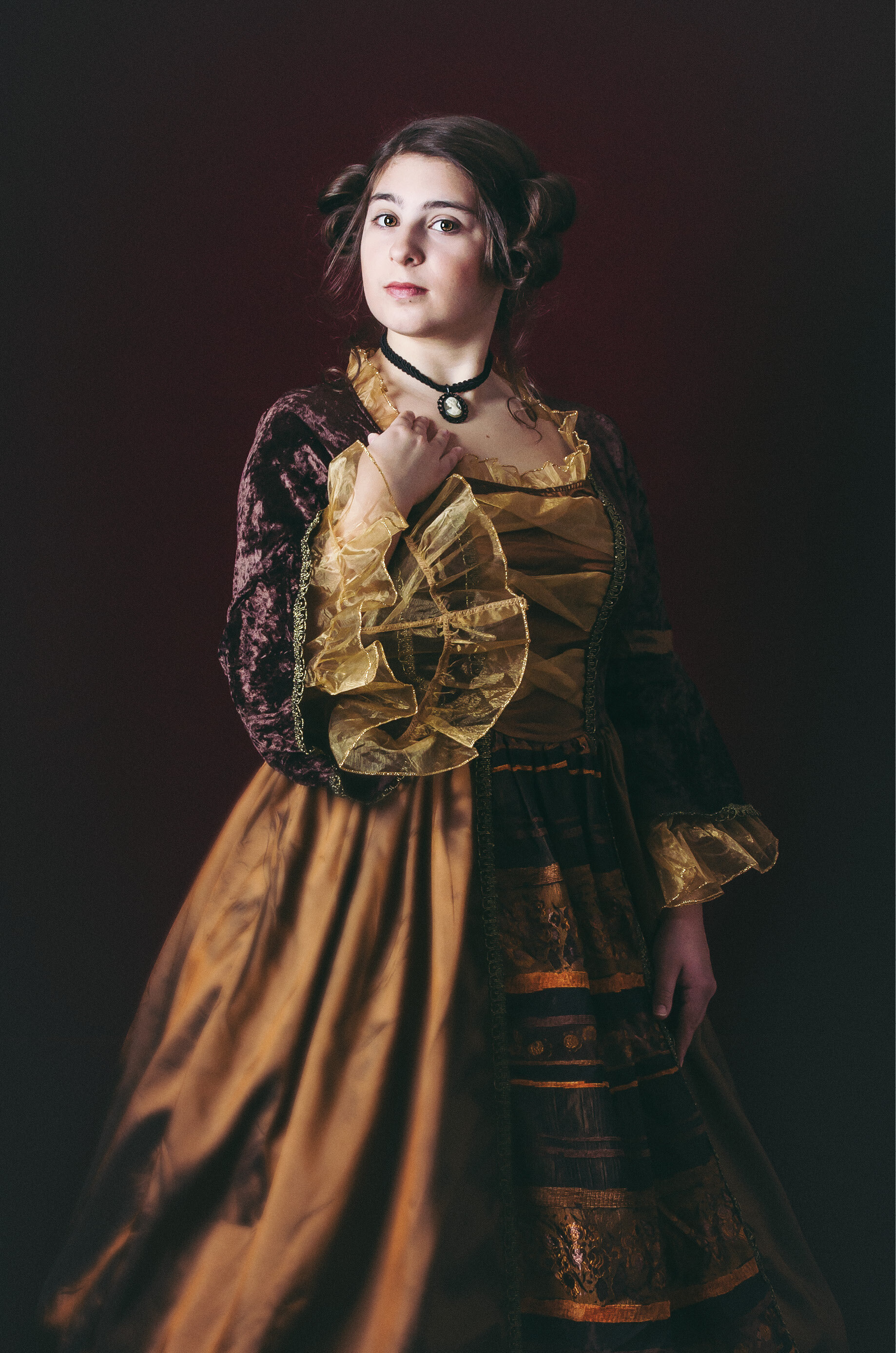Cristin Bobee Graduate Thesis Exhibition:
A Seat at the Table
A Seat at the Table
For much of history, Anonymous has been a woman. Oftentimes their story is one that is augmented and told to suit the needs of the person telling the story.
I photograph these women because I am compelled to
I photograph these women because they speak to me
I photograph these women so they can be seen
These women are daughters, mothers, sisters, lovers, idealists, doctors, fighters, righters of wrongs, champions of justice, warriors, artists, scientists, writers, redeemers, leaders, caregivers, revolutionaries, and renegades...
I photograph these women because I need to know them
History is about fragments. Fragments of ideas, theories, movements, wars, and people. This is a celebration of women.
Growing up, I was told about all the men who did great things in history, there were thousands of them. But very rarely did I learn about the women, and when I was taught about their contributions they were often considered insignificant. I learned about Betsy Ross who sewed the flag for the 13 American colonies as a helper for the founding fathers. However, I didn’t learn about Mary Katherine Goddard who printed copies of the Declaration of Independence with the signatures on them, an act of treason if she were caught. I did learn about Cleopatra and how she used her feminine wiles on Julius Caesar, but not that she was highly educated and intelligent. I was told how Marie Antoinette said “Let them eat cake,” when she didn’t, but not that she was married off at 14 to help form an alliance between France and her homeland, Austria.
The title of this work alludes to an art piece by Judy Chicago called “The Dinner Party.” She created a triangle table with 39 place settings for women of historical significance, with additional place settings for 999 more women. Much like the Chicago art piece, there are a variety of women in these pages who have accomplished great feats. Some have written books, while others have taken command of their tribe or country in times of upheaval, while still others have been misunderstood and maligned.
The photographs of these women are not meant to be completely historically accurate, it wasn’t meant to be a historical production. These are portraits. Artists have been making portraits of people for thousands of years. Wealthy Roman citizens had a tradition of having busts of themselves made out of marble to showcase in their homes. Kings, nobility, and the wealthy commissioned artists to paint their portraits as well. This tradition is rooted in power, wealth, and elitism, only those with money could have these works created, only if someone were important. These commissioned portraits were also curated to show the subject as they wanted to be viewed, and less about reality. This project is about using the genre of portraiture while working within the framework of valuing those who were not valued, and showing others through a different lens. The images are meant to have a painterly quality to them. I use the photograph to purposely and intentionally manipulate the image, making the photos look painterly. The costumes, posing, lighting, gaze of the model, photo manipulation, and texture all work together to create a painterly photograph. These images give power to the women portrayed in them, in the same way, paintings done by the old masters were a way to show how much power their wealthy patrons possessed. The process of creating these images is meant to seem like we are looking at actual artifacts of these women, a sense of going back and looking at history through a new lens.
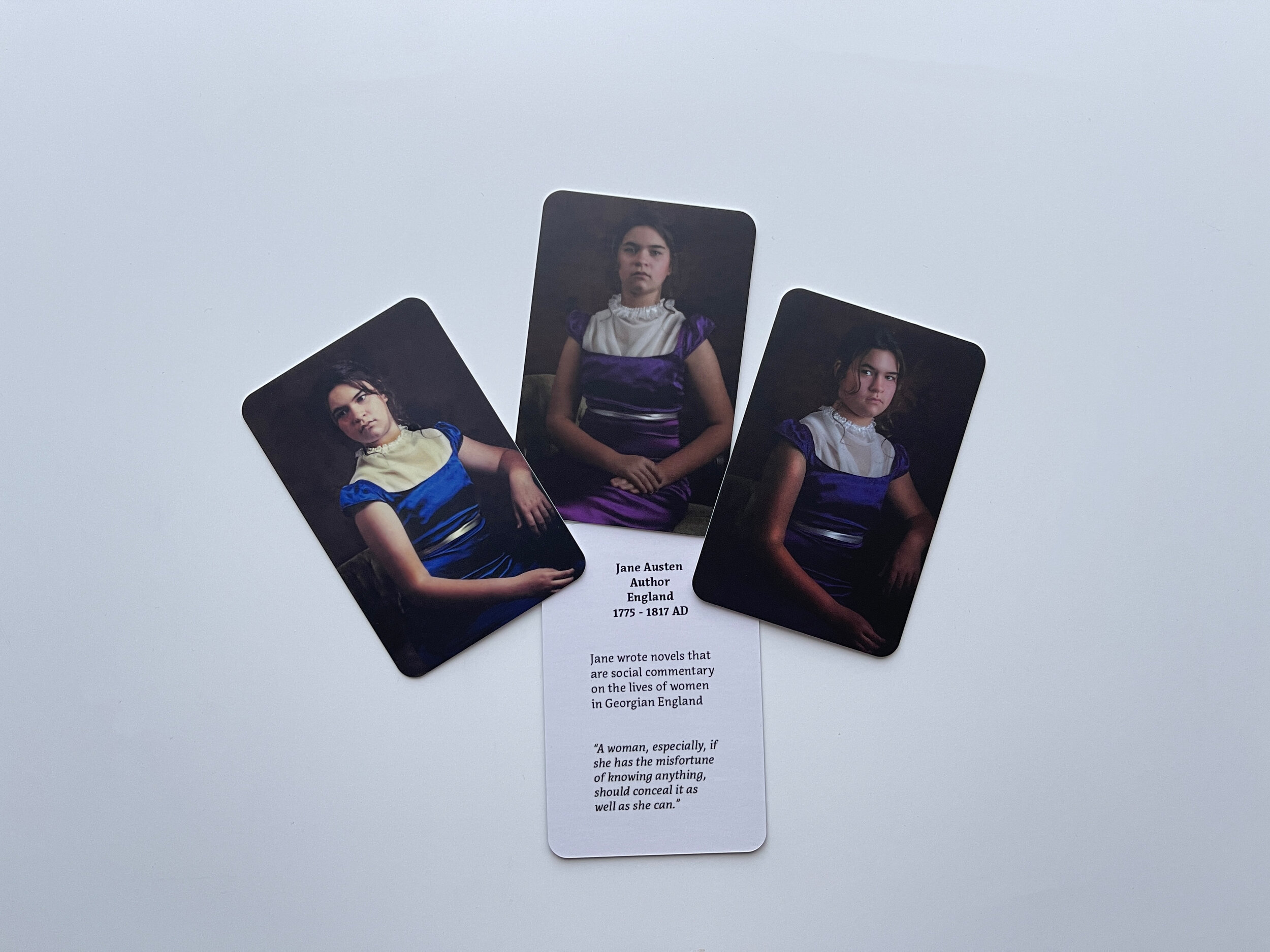

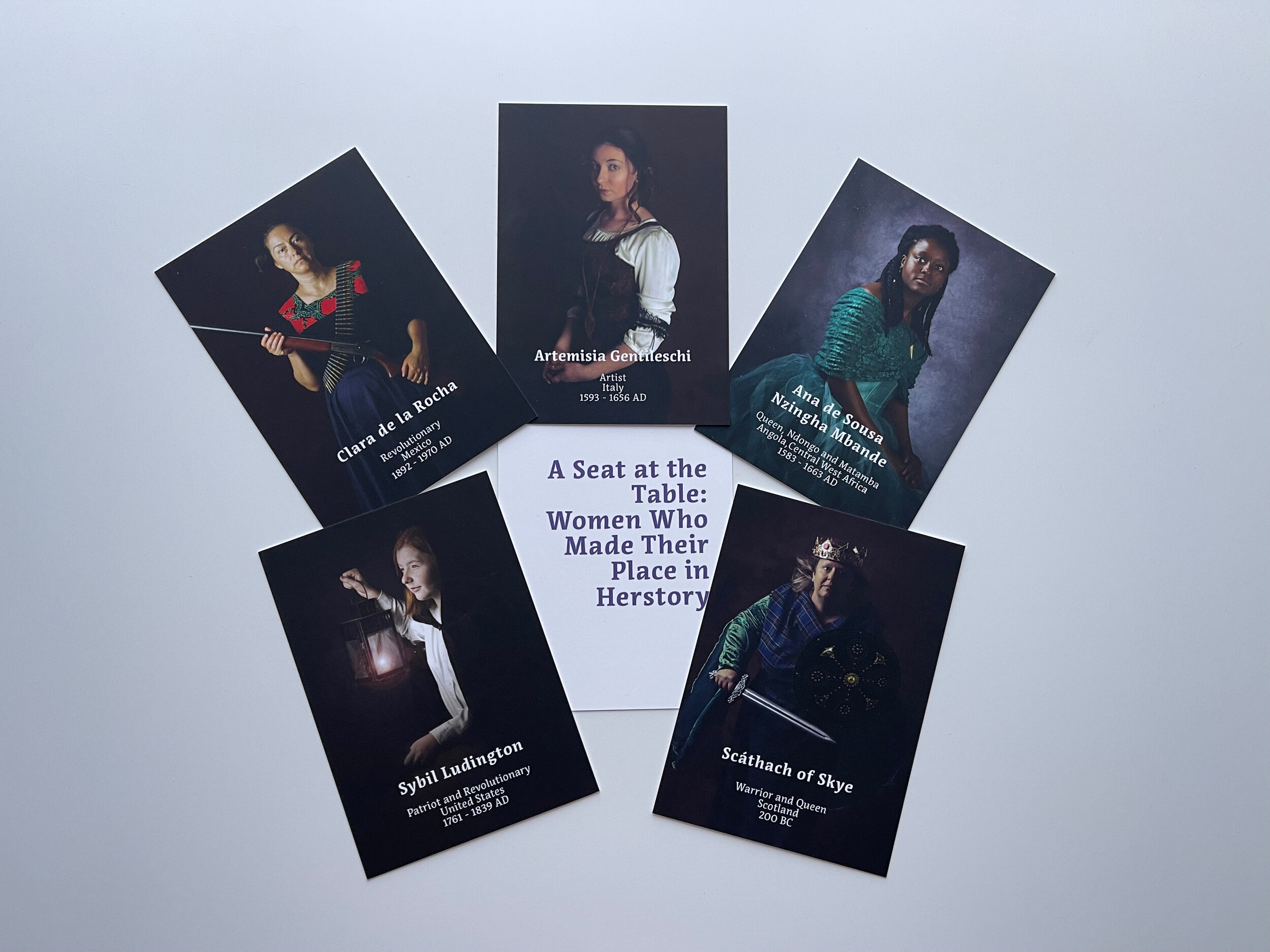
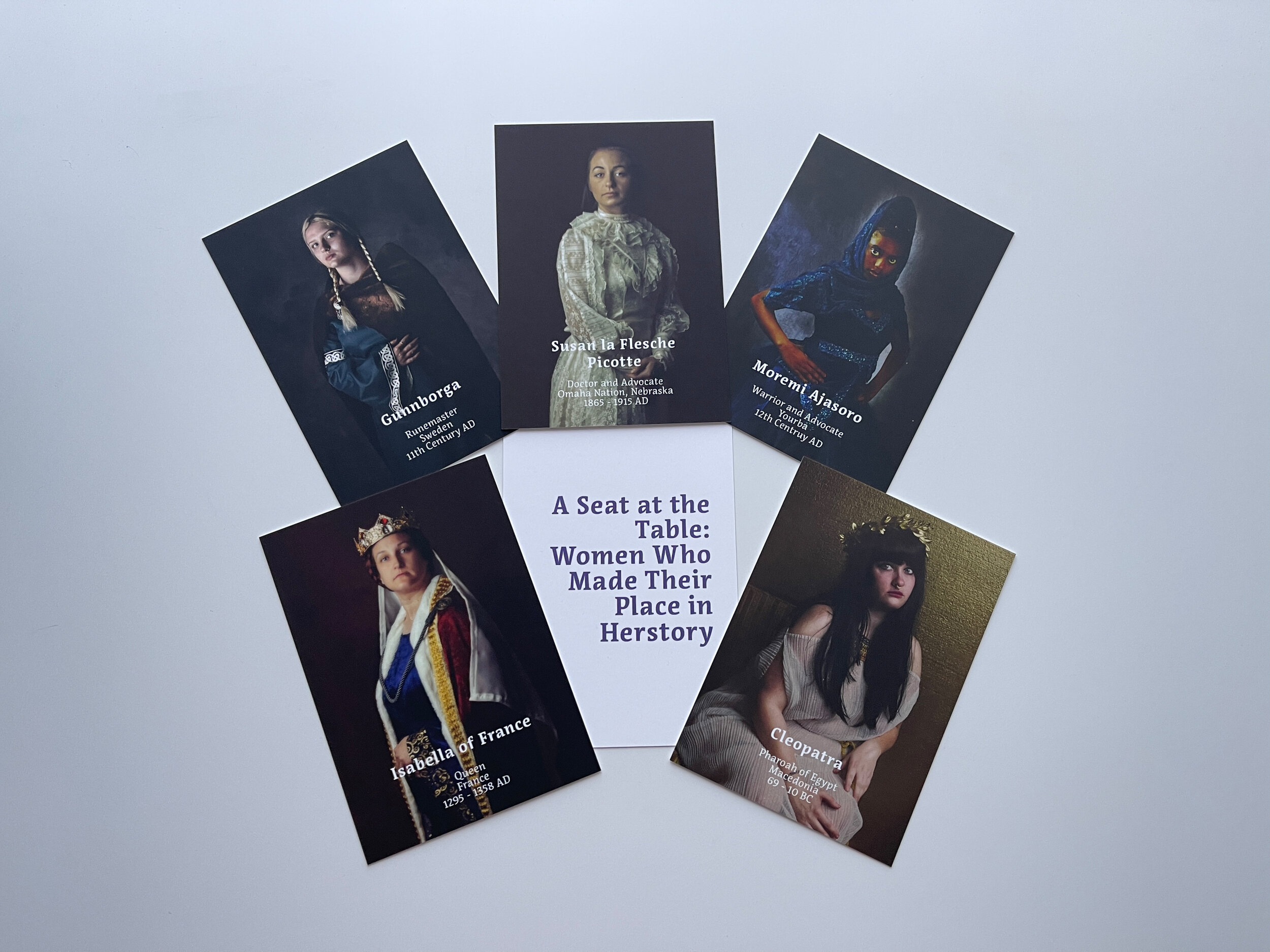
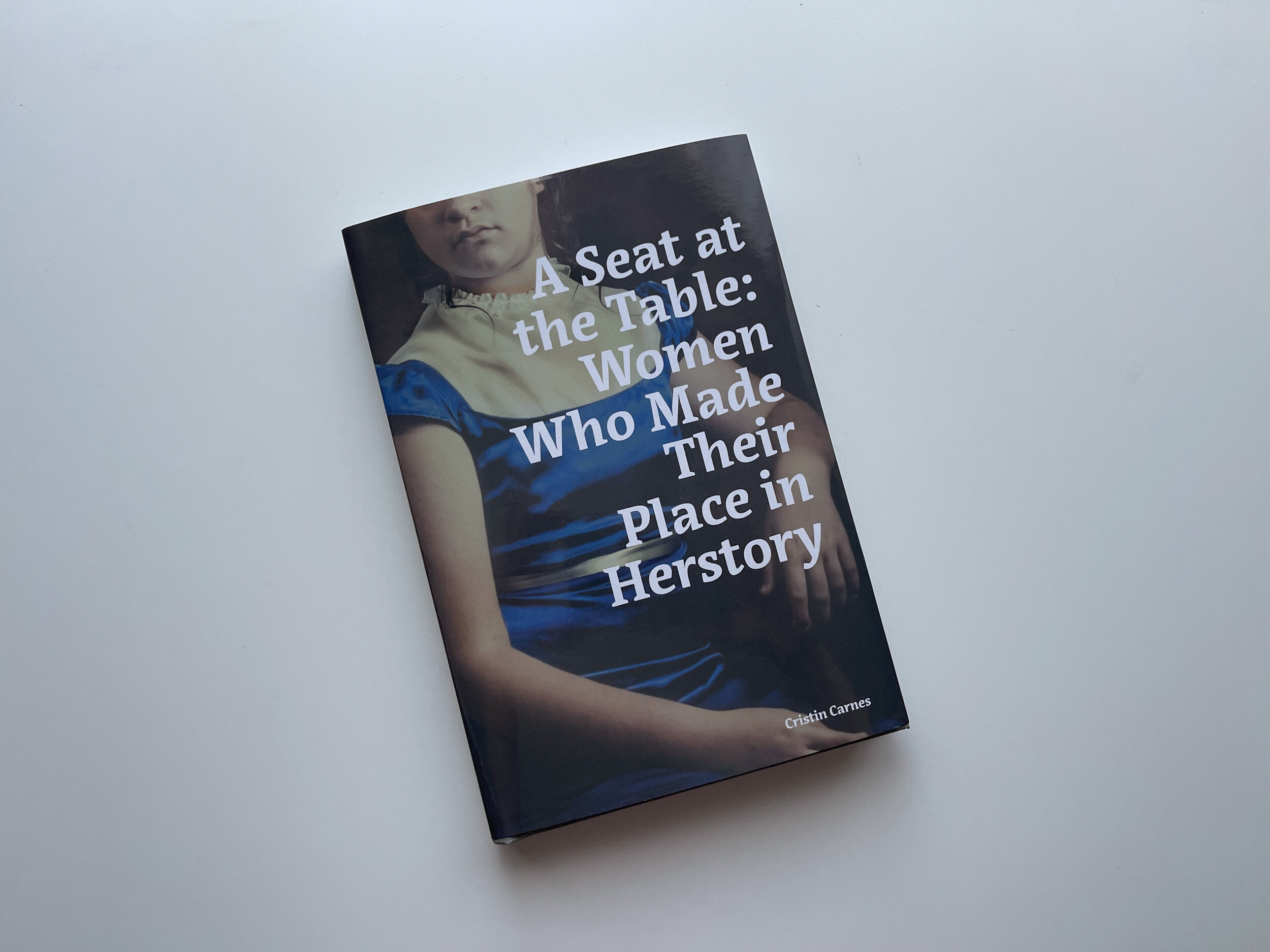


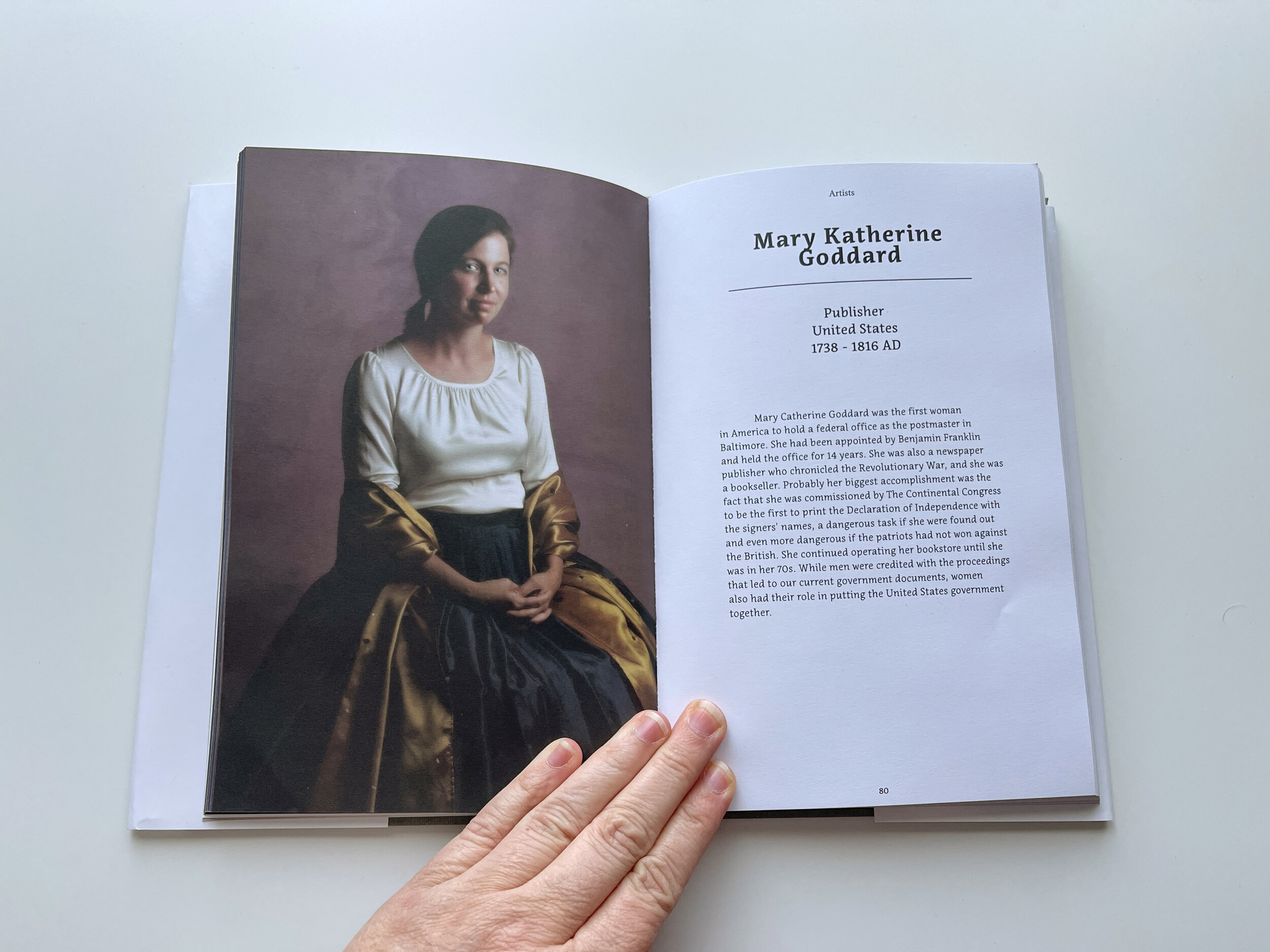
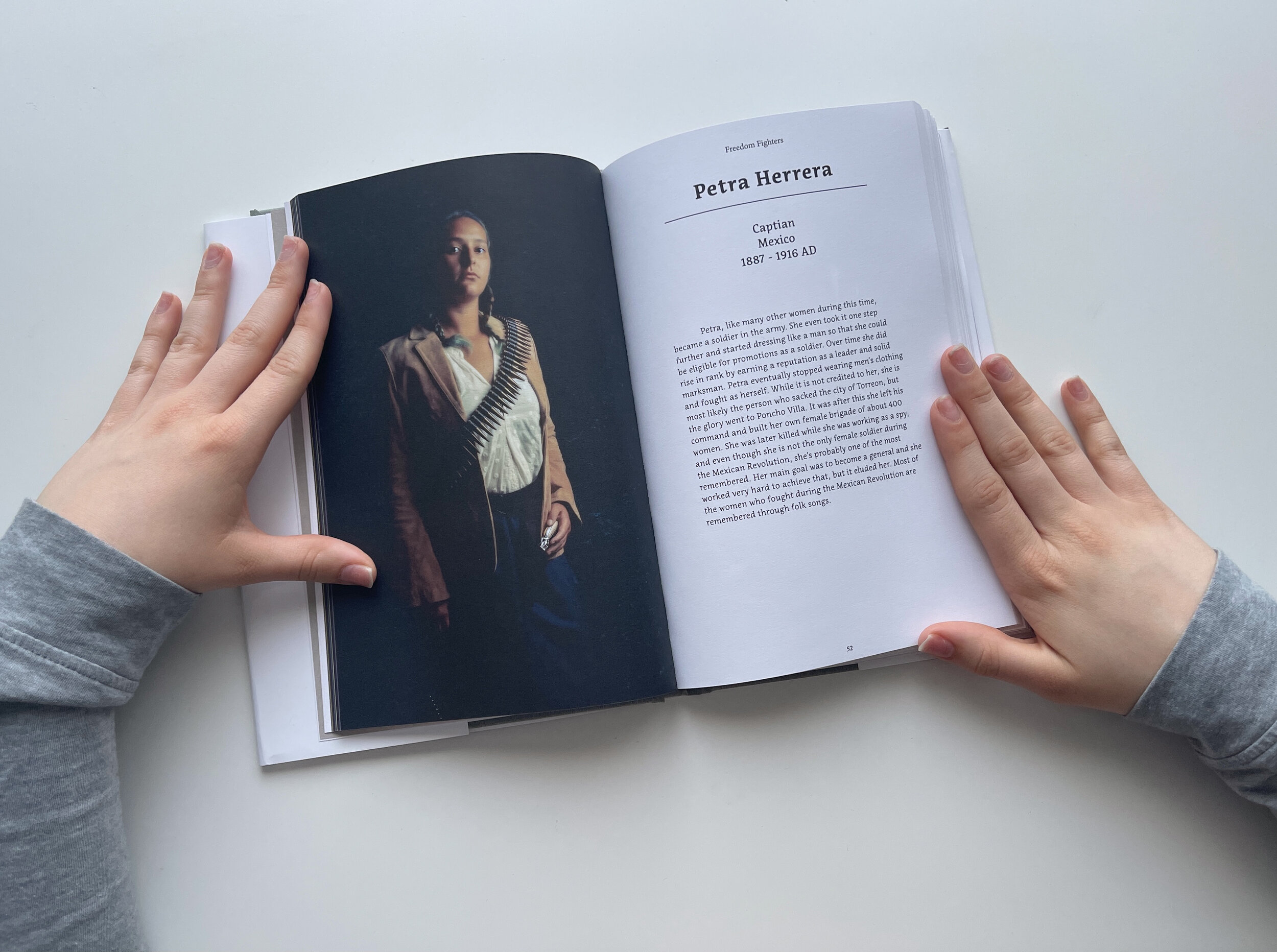
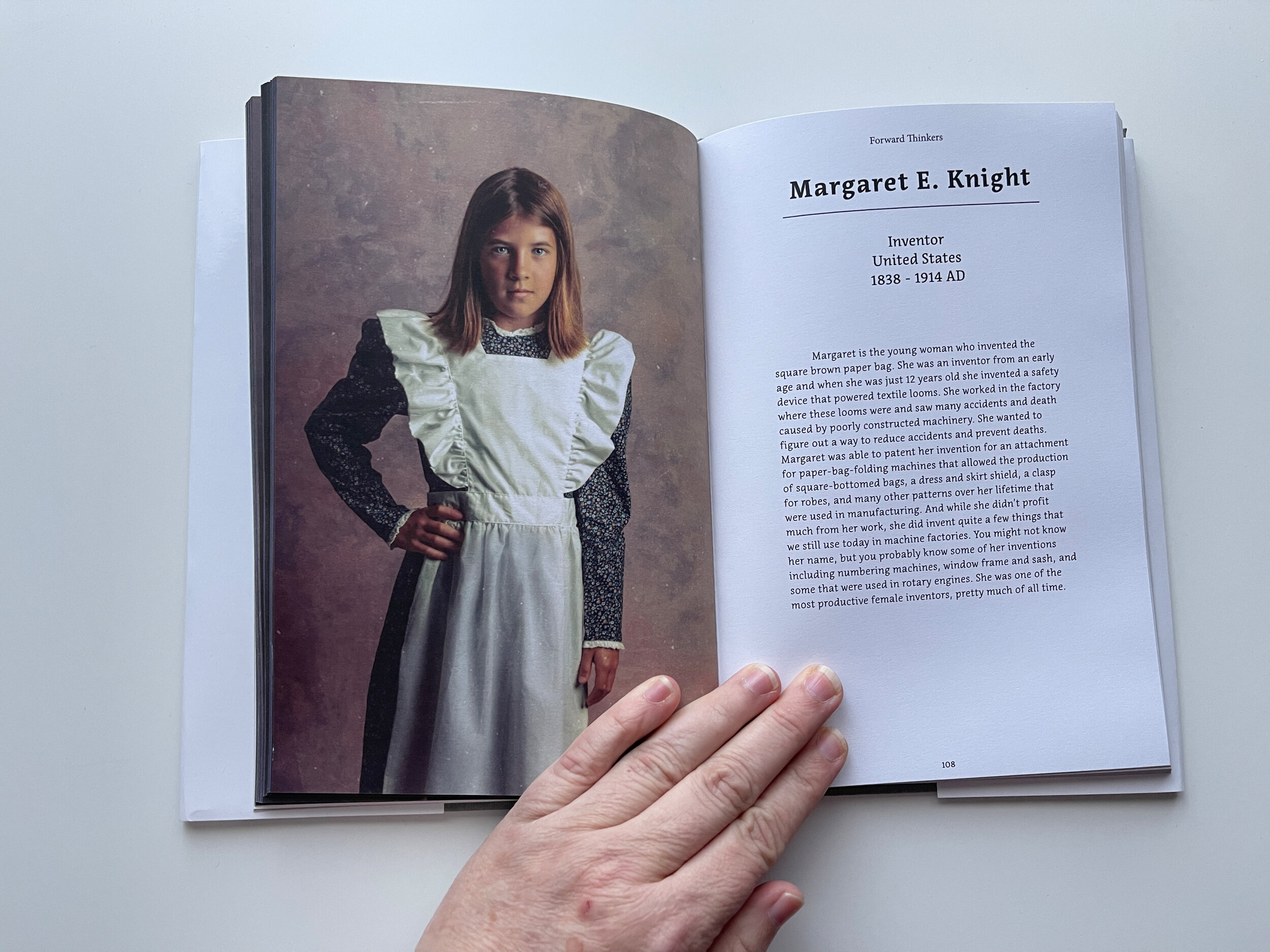
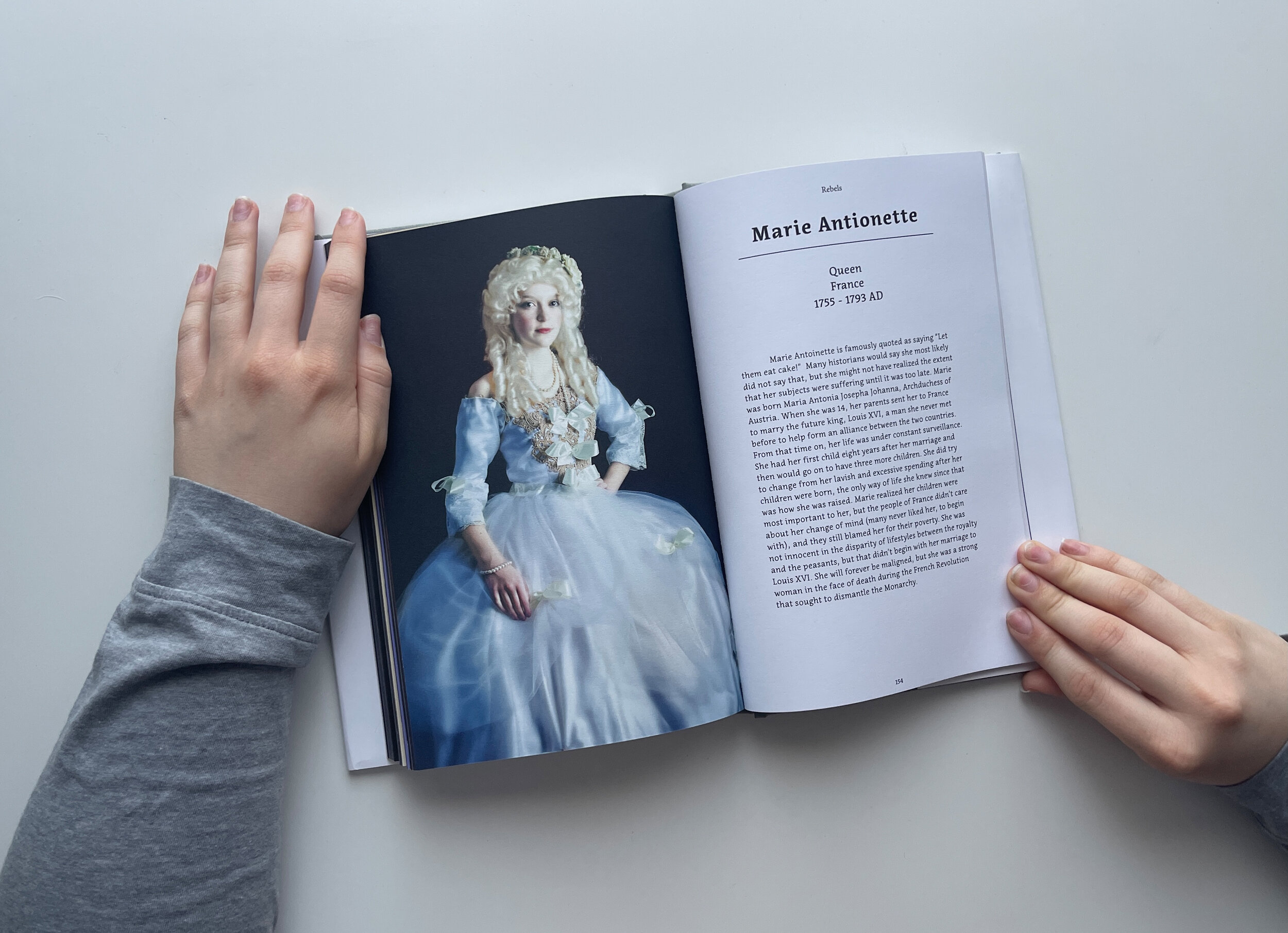

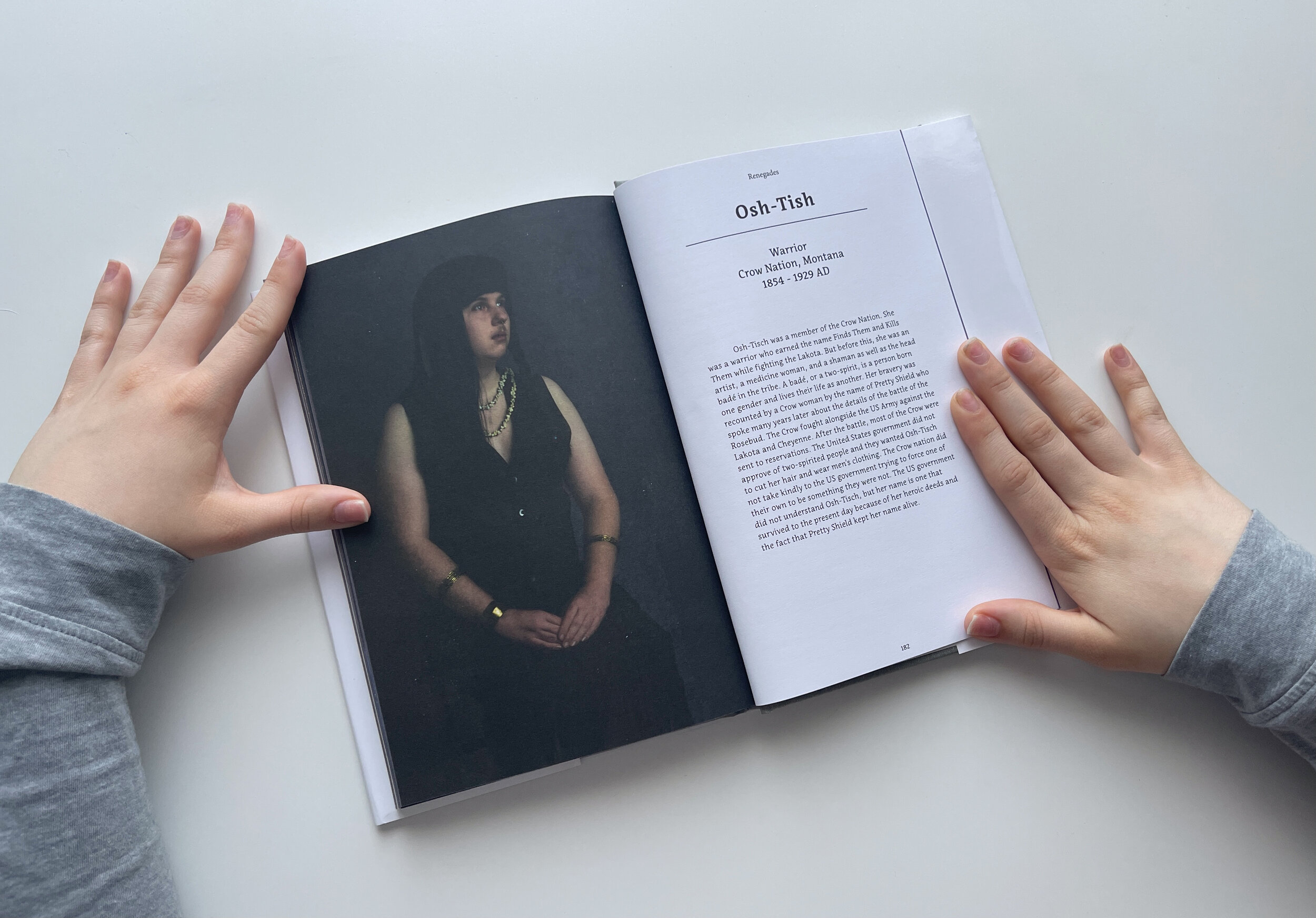

Emilia Plater
Leader in Baltic Revolution Poland/Lithuania 1805 - 1831 AD
Emilia was born into a noble family; she was a strong supporter of her Polish–Lithuanian heritage. When the Imperial Russian army was forcing people to join, there was a group that was mounting an uprising. Plater felt it was her duty to join them, some even say that she was excited about this opportunity in part because she did not live the conventional noble lifestyle of women of her time. She did things like ride horses and shoot guns, something that her female counterparts did not and were not allowed to do. Unfortunately, the uprising was not a success for the Polish people. Plater became ill and died as a result of her illness from the battle. But her legacy lives on in Lithuania, where there are statues of her and her face is on their money. She also has some literary works published about her and she pushed against the notion that only men can fight in war.
Nur Johan
Emperiors Consort Afghanistan 1577 - 1645 AD
Nur Jahan was born into an aristocratic family and married young, but her husband died soon after. She caught the eye of the Emperor and became one of his many wives. However, nine years later, she had the right to a sovereign rule and soon was in charge of the whole empire when her husband was ill or absent from the Palace. When the Emperor was captured by rebels (most likely one of his sons who wanted to overthrow his father) Nur mounted an army and rescued the Emperor. Along with the Emperor, Nur supported the arts throughout the kingdom and created beautiful gardens for public and private use. She had many loyal men who she entrusted to speak on her behalf in matters of governmental decrees because it was not allowed that a woman speak in public. This made her position even more important. She was able to appoint family members and people she trusted to help her.
Artemisia Gentileschi
Artist Italy 1593 - 1656 AD
Artemisia, the daughter of the renowned painter Orazio Gentileschi, is often called one of the best female painters of the Baroque period in 17th century Italy. But she was THE best painter of the Baroque period. Most of her artworks are exclusively about powerful women, oftentimes using her face as the model for the women in her work. While her father was also a well-known painter, her life as a painter was not an easy one. She worked very hard to earn her place as the first woman to ever become a student at the Accademia delle Arti del Disegno, the most prestigious school in Italy at the time. She was almost virtually forgotten until the 20th century when in 1991, she had her first art exhibition. Since then, historians have worked to restore her to a position of prominence within the art world and she is considered a modern-day feminist icon.
Ana de Sousa, Nzingha Mbande
Queen, Ndongo and Matamba Angola, Central West Africa 1583 - 1663 AD
Ana de Sousa was born into the ruling family of Ndongo and Matamba. When the Portuguese tried to take over her nation, Ana’s brother made nice with them. When he ascended to the throne, they threw him in jail. Ana was not happy about this because she was tired of being oppressed by the Portuguese and went to them to demand her brother be returned. Somehow she convinced the Portuguese to let her brother go. He died shortly after that and she took over as leader. For the next 35 years, the Portuguese tried to subject her people and her nation to their colonization. Ana was able to keep them at bay, finally negotiating a peace treaty only after years of using guerrilla warfare tactics and digging trenches around the land to keep the Portuguese out. She lived to be 81 years old and in present-day Angola, there are statues of her all over the place.
Clara de la Rocha
Revolutionary Mexico 1892 - 1970 AD
Clara de la Rocha was the commander guerrilla during the storming of Culiacan, Mexico in 1911. Women fought during the Mexican Revolution as Soldaeras (women soldiers) or Adelitas, which were women who were in the military and participated in the conflict. Clara became a revolutionary to fight for her people and her homeland, and the Adelitas were considered an important part of Mexico’s rebellion. Clara was an excellent marksman and an intelligent soldier. She was promoted to Colonel during her time as a soldier. Does the hairstyle look familiar to you? George Lucas looked to the women of the Mexican Revolution to help in forming the identity of Princess Leia in the Star Wars movies. Clara inspired Lucas when he created the character of Princess Leia, hair and all.
Wu Zetian
Empress China 624 - 705 AD
There are a lot of rumors that swirl around Wu Zetian that are negative, most of them were spread by those that she angered, while those that she treated well spoke great things about her. She was China’s first and only female emperor to rule on her own. Wu Zetain began her political career as the consort of Emperor Gaozong, and after he died, she placed her oldest son on the throne. He angered people and the government because he ruled with himself in mind, so she took him out of office and tried to place her younger son in that position. However, her second son didn’t want the job, so Wu Zetian declared herself the emperor. She began the Zhou dynasty and ruled in the way she saw fit, putting people in power, and removing others from their position, squashing rebellions, and making China a Buddhist country. She even decided when she would renounce the title of Emperor. She’s known as one very tough Emperor who did a lot of horrible things, many of which some scholars are not even sure she did because of all the misinformation about her rule.
Simone de Beauvoir
Writer and Philsopher France 1908 - 1986 AD
Simone was a woman who knew she was just as good as any man, even if the society she was born into said otherwise. She lived in a time when women were viewed as inferior to men. Because Simone experienced these ideas first hand she wrote a book titled The Second Sex and in it, she outlined the oppression of women. She worked as a teacher until she was able to support herself as a writer. Today, this book stands as a seminal text for the modern feminist movement. Even though she wrote many other works throughout her lifetime, this book is her most famous. She is a controversial figure because many people focused on her personal life such as her open relationship with Jean-Paul Sartre, and her relationships with young women as well, which were often the main focus of the questions she would get when she gave speeches or was on a panel. She was a force to be reckoned with and her works are still read today. Simone’s influence on feminist ideas and feminist theory continues to ripple through most of the western world.
Murasaki Shikibu
Author Japan 973 - 1014 AD
Murasaki Shikibu is viewed as the world’s first person to write the modern novel. She was born during the Heian period in Japan, in a time when most people wanted to have boys. Her father let her learn lessons with her brother so she could have a good life. She was educated in many Chinese classics, which caught the eye of the Imperial Court. She was brought to the Imperial family and began writing her most famous novel The Tale of Genji. She spent the rest of her life at court even though her novel seems to be a commentary about the frivolousness of court life and her observations about the upper class of society. Her story was told over and over again throughout Japan during her lifetime and after. Her novel has been translated into many languages and is studied by college students, even in the 21st century. Her work is considered the first novel, and it is amazing that a writer from 1000 years ago still has relevance today.
Susan la Flesche Picotte
Doctor and Advocate Omaha Nation, Nebraska 1865 - 1915 AD
Susan grew up in Omaha on a reservation surrounded by sickness. She would often watch other people die because the white doctors just did not come or care. When she was old enough she was admitted into Hampton Institute, which was the only school for women to become doctors. She paid her way through college and medical school by sewing clothes and did not even stop to go home when her father died. She graduated as valedictorian in his honor. She went back to the reservation and worked tirelessly to help her people. She was more than a doctor to them, she also gave legal and personal advice. She married Henry Picotte and had their son. In January 1913, her dream of opening a modern hospital for the Omaha people was realized, but two years later Susan died. The legacy that she left behind is still present among the Omaha Nation. She was the very first Native American doctor, and her tireless legacy helped her people.
Radclyffe Hall
Writer England 1880 - 1943 AD
Radclyffe Hall was born Marguerite Hall and was known to her loved ones as John. Radclyffe created a cultural revolution with the publication of her book The Well of Loneliness. She dressed in men’s clothing, she had a same-sex relationship in a time when it was not only considered immoral but was also illegal, and she even wrote about it. She made the hero in her story a lesbian and someone who was likable as well. Not everyone liked her book or any of her writings, which caused her to be arrested because she wrote about same-sex relationships, which were illegal. Hall’s publisher brought in many writers and artists to testify on her behalf during her trial, including Virginia Woolf. It was decided by the courts that her book be destroyed and Radclyffe had to pay for court costs. While the British banned her, American editors got the rights to publish the book and, as a result, The Well of Loneliness made its way into culture via American booksellers. Hall went on to be considered a cultural icon as the first writer of lesbian literature.
Maria Mozart
Virtusio and Musician Austria 1751 - 1829 AD
Maria was the older sister of Wolfgang Amadeus Mozart, and many would say a better musician than her brother ever was. She was just seven when she began to play, and Wolfgang also wanted to learn as well. When Maria was just eleven and her brother eight, they began to tour Austria with their father. They performed for the Queen. But as it came time for her to get married, she was no longer allowed to tour. She was relatively unknown until the 21st century when a playwright named Sylvia Milo discovered her portrait and began to research her. Sylvia wrote a play called The Other Mozart, where she outlines Maria’s genius as a writer and a performer. Most of her musical works are lost to us, and it is possible some of the works attributed to her brother were Maria’s work or came from their collaboration. It is unfortunate that when she got married she had to stop playing because, who knows, maybe we didn’t hear from the real Mozart genius.
Gunnborga
Runemaster Swedish 11th Century AD
Gunnborga is the only woman on record as being a Runemaster. A what, you might ask? A Runemaster was a person in Norse culture who carved runestones as a way to mark burial rites and other forms of record-keeping. It was important to Vikings that bravery was celebrated and that the glory of those that died was commemorated. These stones were carved by people, like Gunnborga, who wanted to show the achievements of either themselves or their relatives. Many of these stones were set up in public places so that people could stop and admire them in much the same way that there are historical markers throughout the United States. Most of those who inscribed the stones were not masters, but apprentices who were in training to become masters. Most times the master would sign the stone. Gunnborga is the only known female of record to become a master of this profession. While she is known to have cared as a Runemaster, not much more is known about her life beyond this.
Scáthach of Skye
Warrior and Queen Scotland 200 BC
Scáthach was a warrior queen who lived on the Isle of Skye in Scotland around the year 200 BC. Scáthach means shadowy and her story is often found in medieval Irish heroic legends and sagas. It is believed that she may have even trained some of the greatest Irish warriors. It is also thought that the demi-god Cú Chulainn helped her overcome one of the neighboring female chieftains, Aoife, who could’ve been her sister. Legend says she was some kind of magician, more likely a druid and that she had the gift of prophecy. Because many stories come to us from an oral tradition, it’s not always easy to know if Scáthach was an actual person or possibly an amalgamation of female leaders. But it was not uncommon for women in Scotland and Ireland to be ruling clan leaders
Linda Brown
Civil Rights Activist United States 1943 - 2018 AD
Linda Brown is the Linda Brown at the center of the Brown vs. The Board of Education case that went before the Supreme Court. During this time, there was a disparity between the way schools were run between the black community and the white community even though the 14th amendment to the Constitution clearly stated this was illegal. The NAACP was working to desegregate schools in the 1950s. Linda Brown was part of a group of children who were sent to a nearby school that was closer to their home than the all-black school that was further from their home. The Brown family did not want to send Linda to the school further away, and they realized that for her to have a better life she needed to switch schools. So her family sued for Linda to attend the school closer to her home, and the case wound up going all the way to the supreme court because this was about Constitutional law. The Brown family won. Linda Brown worked as an advocate for quality education for the black community until she died in 2018. She even worked with the Topeka Schools to bring a case against the Kansas Board of Education when her children began attending there and she realized that segregation was still happening.
Anne Boleyn
Queen England 1501 - 1536 AD
Anne became the second wife of Henry VIII after he became enamored with her while she was a lady in waiting for his first wife, Catherine of Aragon. She spent a good part of her childhood in France, and when she returned to England in 1522, she lived at Henry’s Court. Henry even went so far as to create his own religion in England so he could divorce Catherine and marry Anne. Anne got blamed for many things throughout her lifetime. She was seen as arrogant, and as someone who flirted with other men. Anne was not able to give Henry a male heir, their only child was Elizabeth I, and so rumors spread around court about her. Anne was charged with being unfaithful and as a result, she was beheaded in 1536. While she was accused of many things she remained calm at the time of her death. Anne is often remembered as the mother of Elizabeth I, but she was more than that and she was given a bad reputation because someone else wrote her life story.
Sybil Ludington
Patriot and Revolutionary United States 1761 - 1839 AD
Sybil was a teenager during the American Revolution when the patriots needed someone to ride to warn the army the British were headed toward them. Sybil was the oldest child of 12 and her parents owned a farm along the Connecticut coast of Long Island Sound. Her father, a former loyalist turned patriot, was then a Colonial of his local regiment. A rider came to the house one night in April 1777 to warn of a British attack. Sybil’s father needed the rider to go on and warn the others whose farms were in the area, but he was too exhausted. Whether it was her father’s insistence, urging, or her volunteering, Sybil rode all night in the dark and rain between 20 to 40 miles gathering the soldiers to fight off the British troops. While the troops were too late to win the battle, they were still able to fight off some of the British soldiers. The story is important because so often we hear of the midnight ride of Paul Revere, but he was not the only one to warn the patriots of British attacks during the American Revolution. This young woman was able to do the same and we very rarely hear about her heroic act.
Angela Burdett-Coutts
Philantropist England 1814 - 1906 AD
Angela was born into the wealthy family of a rich banker. She had everything a young woman of her class and status could want. But what Anglea wanted was to take care of people, so she refused any suitors because she knew they were only after her money. When her grandfather’s second wife died, Angela inherited all his fortune under the condition that she take her grandfather's name, Coutts, as her surname. Anglea agreed to do that because she wanted to use the money to help the poor women of London, to support the arts, to support actors, to support animal regulations, and to support humanitarian efforts around the world. She was visited by Queen Victoria and the future Queen Mary, and she was also made Lady Burdett Coutts in 1871. Angela eventually married William Bartlett in 1878 when she was 67 and knew she had total control over her financial life. William also took her surname. When she died at 92, she had set the standard for philanthropy that helped people with kindness and without judgment towards those who needed help.
Lady K’abel
Supreme Warrior Maya 7th Century AD
Lady K’abel was a seventh-century warrior queen from the house of the Snake King of the Mayan Wak Kingdom in present-day Southern Mexico. While she was considered physically beautiful, Lady K’abel was the military governor of her kingdom and was married to a leader of another great Mayan Kingdom. However, she outranked her husband as they both ruled the land together. The titles given to her, Lady Snake Lord and Lady Waterlily Hand, did not do justice to how strong a woman she was. She was ultimately given the title of Supreme Warrior. Lady K’abel was buried with over 1600 artifacts including ceramic vessels, jade jewelry, stone figurines, and a small alabaster jar carved in the shape of a conch shell. Today she is seen as a leader who was a force to be reckoned with.
Lyudmila Pavlichenko
Sniper in WWII Russia 1916 - 1974 AD
Lyudmila was at school when World War II broke out and the Nazis bombed her university. This made her decide to join the war effort. It was suggested that she work in a factory or hospital, but because she had earned so many awards for shooting (a personal hobby of hers) she was allowed to become a soldier, specifically a sniper. Fighting wasn’t as easy in reality as it was in theory. Throughout her career, she killed about 309 enemy soldiers, the most anybody had ever killed as a sniper. After she was injured, the Russian government would not let her go back into battle. But she had already made her mark on the war effort and became the most famous Russian sniper to ever serve.
Cleopatra
Pharoah of Egypt Macedonia 69 - 10 BC
There is much written about Cleopatra, it seems that most people know very little about who she truly was as a person. Her beauty seems to be the main focus when talking about her. Born to Ptolemy I Soter, a Macedonian general, Cleopatra was extremely well-educated and a shrewd political strategist. Although not ethnically Egyptian, she embraced their culture and even learned their language. Cleopatra fought her sister and her brother to become the pharaoh, and she aligned herself with some of the greatest men in history to ensure her place there. She did have a child with Julius Cesar, but what some might not realize is that she was very calculated and that Cleopatra curated their relationship. She was an intelligent woman who knew what she wanted and knew how to go about getting it. One of her downfalls was that she loved very deeply and when she teamed up with Mark Anthony to unite against Octavius for control of Rome’s vast empire, she lost her throne and a chance to rule Rome as well. It was a gamble that she was willing to take and as a result, the history books don’t always speak kindly about her.











